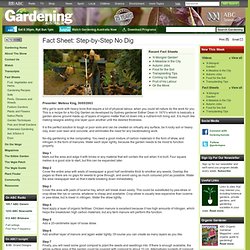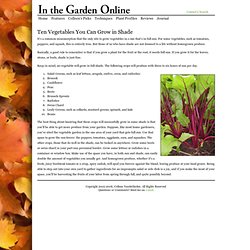

Permaculture- A Beginner's Guide. Gardening Australia - Fact Sheet: Step-by-Step No Dig. Presenter: Melissa King, 30/05/2003 Why get to work with heavy tools that require a lot of physical labour, when you could let nature do the work for you.

This is a recipe for a No-Dig Garden as developed by Sydney gardener Esther Dean in 1970’s which is basically a garden above ground made up of layers of organic matter that rot down into a nutrient-rich living soil. It is much like making lasagne adding one layer upon another until the desired thickness. It is the perfect solution to tough or poor soils and can be created on virtually any surface, be it rocky soil or heavy clay, even over lawn and concrete, and eliminates the need for any backbreaking work. No-dig gardening is like composting. Step 1Mark out the area and edge it with bricks or any material that will contain the soil when it is built. Step 2Cover the entire area with wads of newspaper a good half centimetre thick to smother any weeds.
Step 3Cover the area with pads of lucerne hay, which will break down easily. Building a Vegetable Garden – Natural Gardening – Preparing a Vegetable Garden. Your Complete Instructions for Natural Gardening Success Behind every vegetable plant is a person with gardening desires — you!

And behind you there are bees, worms... and millions of other live inhabitants of your garden soil. To keep them happy, here's how to build your vegetable plot. There is no need to wreak havoc and madly dig. Truly, madly, digging messes up the natural layers of earth that nature has set down. Let the microbes and worms etc do what they do best in their own good way and time. Preparing a vegetable garden of this sort is extremely attractive for those sites that start off with poor soil or invasive weeds. Follow the natural gardening no dig diagram below, but first thing of course is to... Choose the site: Make sure it is roughly level and ideally most of the area gets at least 4-5 hours of sun a day. In the Garden Online - Colleen's Picks - Ten Vegetables You Can Grow in Shade. It's a common misconception that the only site to grow vegetables in s one that's in full sun.

For some vegetables, such as tomatoes, peppers, and squash, this is entirely true. But those of us who have shade are not doomed to a life without homegrown produce. Basically, a good rule to remember is that if you grow a plant for the fruit or the root, it needs full sun. If you grow it for the leaves, stems, or buds, shade is just fine. Keep in mind, no vegetable will grow in full shade. Salad Greens, such as leaf lettuce, arugula, endive, cress, and radicchioBroccoliCauliflowerPeasBeetsBrussels SproutsRadishesSwiss ChardLeafy Greens, such as collards, mustard greens, spinach, and kaleBeans The best thing about knowing that these crops will successfully grow in some shade is that you'll be able to get more produce from your garden. Growing a Healing Garden. Rating: 7.9/10 (9 votes cast) When you visit your local market or garden centre, check out their herb selection.

You may be surprised at the varieties of herbs that are available. Not only do quite a few of them provide beautiful flowers, but there is an added benefit – you can use them for medicinal purposes without a worry. So – what better way to enjoy spring then to get out and get active in your garden, clean it out, plant some pretty annuals or perennials and add herbs as well? Growing a healing garden will be definitely rewarding for you. Here are a few ideas for your own herb garden – easy to grow plants with medicinal properties. Here are 12 the most popular herbs that are easy to grow: Introduction to Straw Bale Gardening. How we turned an old backyard swimming pool into a self-sufficient garden in a desert city.